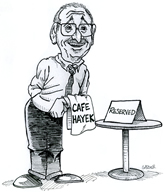President Trump has issued at least three executive orders aimed at stopping racial discrimination, including affirmative action and disparate-impact analysis. The orders fulfill the constitutional requirement of equal protection of the laws, forbidding government from treating people differently based on race. They also reinforce Chief Justice John Roberts’s observation that “the way to stop discrimination on the basis of race is to stop discriminating on the basis of race.”
One simple way that the Trump administration can promote these objectives is by revising the Office of Management and Budget’s Statistical Policy Directive 15, which specifies the kind of data on race and ethnicity government agencies must collect. The current directive is unconstitutional, discriminatory and scientifically unsound.
If OMB revised the directive to prohibit the collection of racial data, it would make it more difficult for regulators and attorneys to devise schemes for government to discriminate by race. Such a protection of Americans’ liberty would be even more robust and enduring if enacted by Congress rather than the executive branch. But in the meantime, a revised directive could halt this unconstitutional race accounting.
The directive has been flawed ever since the OMB developed it in 1977, but the Biden administration last year revised it to expand racial and ethnic classifications, creating more unconstitutional racial bases for government reward and punishment. It created a Middle Eastern or North African race, or MENA; respondents were previously classified as white.
…..
The Census Bureau is using the Biden administration’s flawed methodology to collect racial data for parts of the Current Population Survey and has plans to implement it fully in the American Community Survey in 2027 and in the 2030 decennial census. The Trump administration should stop this discriminatory madness before it’s too late.
Susan Dudley reflects on three new books and their authors’ thoughts on creative destruction. A slice:
Economic freedom and market forces not only incentivize innovation but allow failure, while governments often perpetuate failure by protecting incumbents. And, as Schumpeter showed us, failure is a necessary part of the innovation process.
When House Speaker Mike Johnson lashed out at last weekend’s “No Kings” rallies soon to arrive on Washington’s National Mall, he reached for an old conservative refrain: “They hate capitalism. They hate our free enterprise system.”
I am sure he’s correct about some of the protesters. But the message rings hollow coming from a party leader that stands by as President Donald Trump does precisely what Johnson rightly decries: substituting political control for market choice and ruling by executive order.
Indeed, what began as a populist revolt against so-called elites has become a program of state ownership, price fixing and top-down industrial control.
Protectionist policies — tariffs on Chinese furniture, subsidies for domestic chipmakers, “Buy American” mandates — are building a “fortress economy” that traps sluggish growth and higher prices inside. According to the Tax Foundation, Trump’s tariffs would reduce US GDP by 0.8 percent over the next decade, translating to an average tax increase of $1,300 per US household in 2025. These estimates are understated, as they don’t account for the shrinking choices consumers face and the higher prices for substitute goods.
Trump’s latest round of tariffs on furniture alone will raise prices for millions of households, as his previous import restrictions have already done. In fact, US furniture companies, the supposed beneficiaries of these tariffs, opposed Trump’s plan, arguing that these “tariffs cannot reopen factories that no longer exist, bring back thousands of workers who retired or moved on to other industries, nor reverse the interests and inclinations of today’s younger workers, who are attracted to higher-paying trades.”
Biden’s policies, despite their “green” rhetoric, mirrored this approach, raising input costs and slowing productivity growth without reviving manufacturing or clean energy. In his new book, Crushing Capitalism, Norbert Michel argues that populist agendas are depressing the brakes on decades of unprecedented US economic growth. He explains that the narrative of too much “liberalism” hollowing out the middle class is not only wrong, but dangerous.
It remains genuinely astonishing that someone as obsessed with tariffs as President Donald Trump can also be so maddeningly ignorant about how they actually work.
Case in point: On Thursday morning, the president simultaneously took credit for raising beef prices (with tariffs, naturally) while also demanding lower beef prices for consumers. This reflects an ongoing tension within the Trump administration’s trade policies, as Trump is currently seeking additional beef imports from Argentina to offset the higher prices caused by his tariffs on beef from other countries.
Romina Boccia and Tyler Turman want to “end Obamacare’s welfare for the wealthy COVID credits.”



